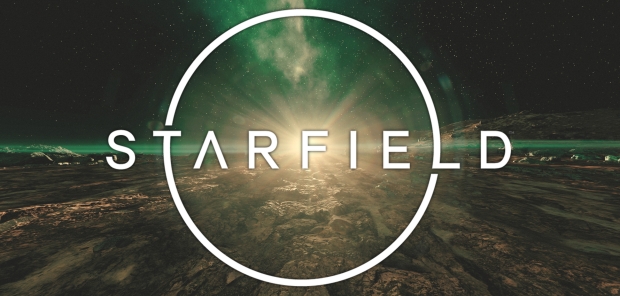
The Bottom Line
Pros
- + Creation Engine 2 shines in some areas, new lighting systems are impressive
- + Memorable visual style that references pop culture and real-world imagery/space photographs
- + Jetpack is awesome and very fun to use
- + New O2/CO2 system is innovative and interesting
- + FPS combat is enjoyable enough
Cons
- - Loading times are extremely frustrating
- - UI can be confusing to navigate
- - No local maps is a pain point, surface maps aren't great
- - Environmental storytelling is too few and far between
- - Some skills and perks feel unnecessary
Should you buy it?
AvoidConsiderShortlistBuyIntroduction
- Developer - Bethesda Game Studios
- Publisher - Bethesda Softworks
- Platform - Xbox Series X (Reviewed), Xbox Series S, PC (Reviewed)
- Release Date - September 6, 2023
- Genre - First-Person RPG
- MSRP - $69.99
Starfield both is and is not like Bethesda's other games. The systems are new, but the gameplay loop is relatively the same. The graphics have been updated, but you can still spot what looks to be Fallout 4 assets on the Xbox version (not that I'm complaining, mind you--I loved Fallout 4).
What makes Starfield so unique is its themes, style, and overall tone. From the get-go, it becomes crystal clear that Starfield is a game that Bethesda wanted to make. The passion is undeniable, and the attention to care and authenticity really invigorates the experience with a kind of believable alt-history life.
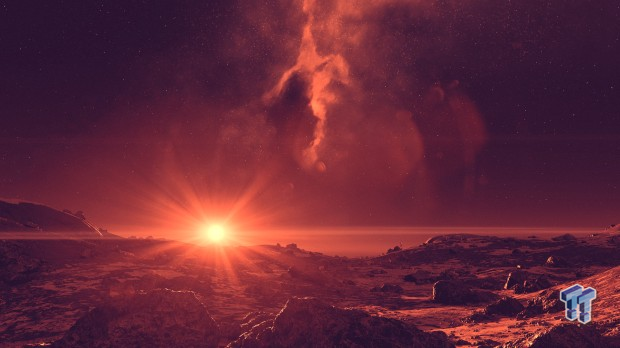

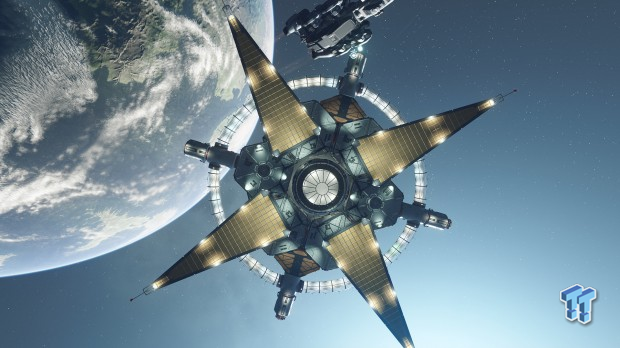

This game feels like a convergence of vision, experience, and innovation, but it isn't without flaws.
One thing I'd like to make clear from the beginning is that Starfield isn't a bad game. It just feels like an incomplete game. From the breadth of content and the sheer amount of work that went into the overall design of the game, I know that it's not incomplete. It just feels that way, and that's where a lot of the friction comes from.


The space sim does have serious issues, though. The biggest gripe I have with Starfield is the loading times. They're bad. Really bad.
The loading situation makes the Xbox Series X's advanced, Velocity Architecture-infused PCIe 4.0 SSD feel like a mechanical hard drive in comparison to something like the PlayStation 5's ultra-fast SSD tech. Starfield fares better on PC, which is rightly so considering my setup includes a 4TB Sabrent Rocket Plus SSD that can achieve up to 7.1GB/sec speeds.
The loading times really are detrimental to gameplay. Having to wait wouldn't be so bad if the loading screens weren't so constant. It seems like anything you do triggers a loading sequence or unskippable animation--fast travel, enter an area, leave an area, dock with another ship.

This brings Starfield's immersion to a screeching halt. Nothing takes me out of a game quicker than a loading bar. This is one of the reasons why Sony's first-party PlayStation 5 games can be so impressive--they can be optimized to push crazy-fast loading sequences like those seen in Ratchet & Clank Rift Apart.
The loading times feel like a crippling blow to the game because Bethesda has clearly put a tremendous amount of work into making Starfield look and feel believable, at least within the confines of our own reality. Sure, we don't have grav drives that let us jump through star systems, but the planets, moons, and stars are based on real data gleaned from NASA.
Bethesda gathered and adapted tons of real-world data to make Starfield look and feel authentic. And it shows, too; landing on Mars and roaming around really does make you feel like you're actually there. Everything seems to match up pretty well, and Starfield is kind of like jumping right into an episode of Cosmos, maybe playing an interactive space encyclopedia.
The loading screens snap you back to reality...and quick. Starfield's loading sequences are so long that they remind me of playing the launch 2011 version of Skyrim on the Xbox 360 (if you know, you know).
While I can't pretend to know the complexity behind Starfield or why it takes so long to load, I can say that it's a significant hindrance to the fun factor of Starfield.
That brings me to the next point: Is Starfield actually fun?
Yes, I think so. But my definition of fun might be different than yours. So let's go over a quick checklist of what Starfield is and what it isn't:
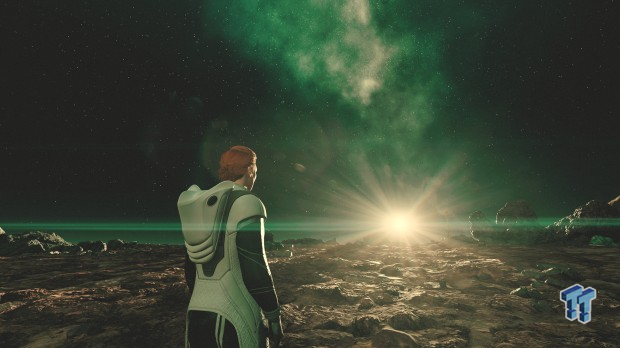
What Starfield is
- It's a methodical experience - Starfield is a game you can sink a lot of time into. It's built around the awe and mystery of the cosmos, where most of the exploratory reward is what you see with your eyes rather than what you earn or what you accomplish.
- It has memorable quests - This is one of the key areas where the game shines. Starfield offers a lot of unique quests and missions, to the point where even sidequests are surprisingly layered.
- It invokes the beautiful bleakness of space - Todd Howard said that Starfield aimed to deliver the "magnificent desolation of space," a quote lifted from astronaut Buzz Aldrin. I'd say Bethesda hit the mark dead-on. The game delivers a certain tone while exploring the reaches of space, offering an introspective journey across the galaxy.
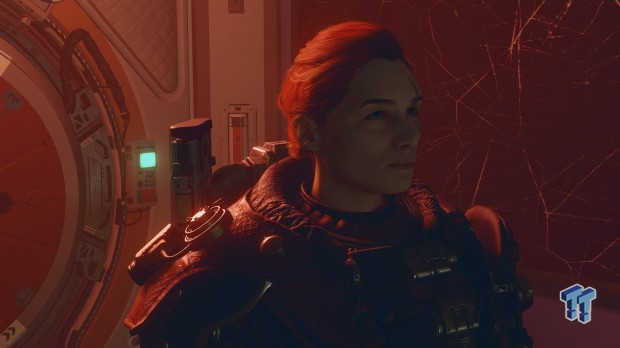
What Starfield isn't
- It's not an action-packed game - Starfield's combat is indeed primarily first-person, but you're not really going to be zooming around like you would in a game like Doom Eternal.
- It's not Skyrim or Fallout - There are no VATS or medieval weapons, and the game itself is much more stretched out instead of being more condensed with pockets of environmental storytelling (this still exists in Starfield, but it takes longer to find)
- It won't deliver quick dopamine hits or rapid interactivity - Bethesda has created another slow-burn RPG, but this time, the gameplay is likewise stretched over a wider range. Lots of loading screens and navigation through layered user interface (UI) systems can feel like a chore at times.
- It's not Star Wars, Star Trek, or even Mass Effect - Although it shares themes with practically all sci-fi media, Starfield seems like more of a game that Carl Sagan would play. The game lacks a colorful cast of aliens and creatures outside of the procedurally-generated lifeforms you'll find spread across various planets. There's no intelligence E.T.'s out there.
- It's not No Man's Sky - You can't actually land your ship on a planet, nor can you fly your ship above a planet's surface or in its atmosphere. Ship flying is exclusively relegated to in-orbit travel outside of a planet.
- It's not Breath of the Wild or Tears of the Kingdom - Nintendo broke the mold and re-defined what open-world games could and should be with its modern Zelda duology, but Bethesda missed the memo. A lot of Starfield's exploration will yield impressive visuals and a few scattered things to uncover, but these journeys overall don't feel very meaningful.
Now that we've gotten that out of the way, let's delve into the basic mechanics of the game.
Design and UI
Starfield mostly suffers from its ambition. Bethesda's vision for this game seems to outstrip the technological capabilities of today's consoles, and the overall scope is just so wide that it feels like the studio's focus was stretched out too far instead of delivering a more concentrated experience.
The game's UI is one of the biggest design decisions in this vision.
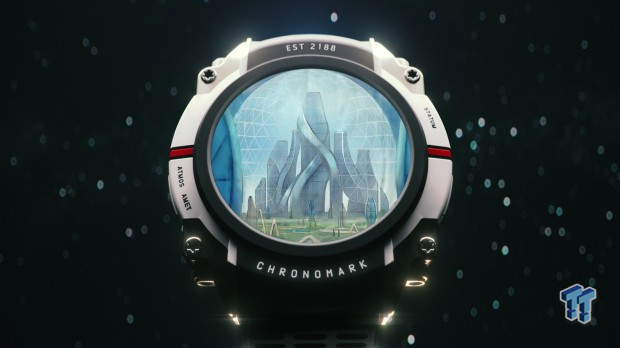
From my understanding, the entire game UI is based on the Starfield watch, a.k.a. the Chronomark. It's basically a high-tech, futuristic version of a smartwatch. The game UI is meant to be contained in the watch face, hence the circular menu design (stylish, but also reflective of shape of our home device). The Chronomark is to Starfield what the Pip-Boy is to Fallout.
My intuition tells me that the Chronomark is essentially our deep-future version of a smartphone, complete with AR interfacing overlays. The scanning tool also has a circular targeting reticle.
This design path has proven to be troublesome.
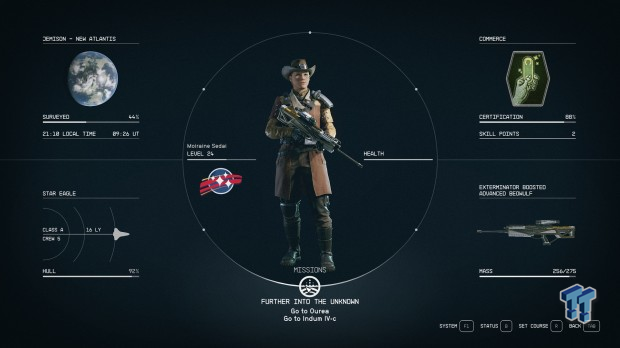
While appealing to the eye, the user interface isn't all that unique or original. Where Starfield's UI sets itself apart is the various shortcuts that it offers gamers; you can press R1 while your scanner is active to open the local map or use the missions tab to quickly select your next relevant location path.
The shortcuts actually feel necessary due to the more complex design of the interface. However, it's still a nice little time-saving addition that Bethesda has put into the game. It's one of many quality-of-life adjustments that make Starfield more player-friendly and pushes the game away from the "hard sci-fi" genre.
You really need to get used to seeing Starfield's various screens, though. You'll be spending a lot of time navigating the various menus, whether it be sorting loot, popping in new skill points, or zapping to new locations.


Oblivion's menu is linear 2D with a filigreed and appealing visual style.
The UI design is partly responsible for one of the biggest immersion-breaking disconnects that afflicts Starfield. Yes, you do spend a fair bit of time navigating menus in typical Bethesda RPGs, but those games are a lot less layered and more straightforward than Starfield.
To conceptualize this: Most games have "2D" style interfaces where things are listed in a linear, left-to-right basis. Starfield has a "3D" interface where things are layered on top of one another instead of set side-by-side on the same plane. Skyrim also had a 3D layered interface.



Morrowind's menus are also 2D and set the overall theme for future Bethesda games, including the trend of having two maps--global and local. Starfield iterates on this trend by adding a third map.
Starfield's UI is an evolution of what Bethesda has done in the past, but this can be detrimental due to the 3D layered design. Navigating the menus can be confusing at first, and even once you get the hang of it, things can still feel a bit off.
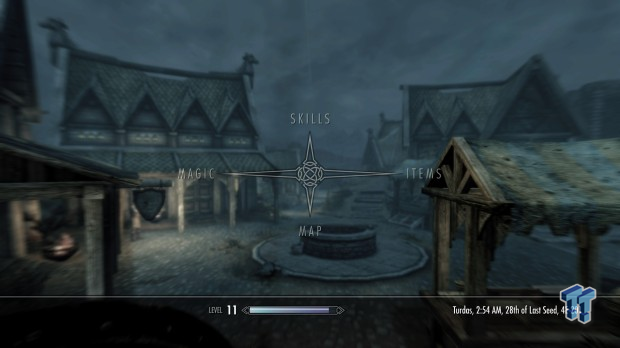


Skyrim also had a 3D layered interface where selections led to other menus, but it also featured a more straightforward world map and local map combo.
This is mainly due to the fact that Bethesda has decided to split its map sections and go a similar route as Mass Effect Andromeda's scanner system. Starfield also has a scanner, and to be fair, it's pretty interesting to use but not entirely necessary. The scanner screen has a quick launch shortcut to view the local map of any given area.

These local maps, aka "surface maps," are not great or really useful outside of a simple and unfinished compass screen. There are no detailed local maps like in previous games--this time, the visuals are very barebones.

Also, I have a very big problem with the indicator that Bethesda chose to use for your player's location on the surface map. In most games, this is denoted by a simple triangle. The tip of the triangle is where your character is facing. But not in Starfield; your character's location is denoted by a confusing cone structure where the flat side of the triangular shape is where you're facing.
This is needlessly confusing and needs to be changed as soon as possible. It's very hard to see this cone while playing the game on an Xbox console and a big-screen TV.
I understand what Bethesda was trying to do here--incorporate a scanning aspect to increase the amount of gameplay loops and feed into exploration--but ultimately this doesn't feel like something that players really need to do. I can't remember really ever being enthusiastic about scanning planets or locations. At most, it's been a general curiosity, but not any kind of burning desire.
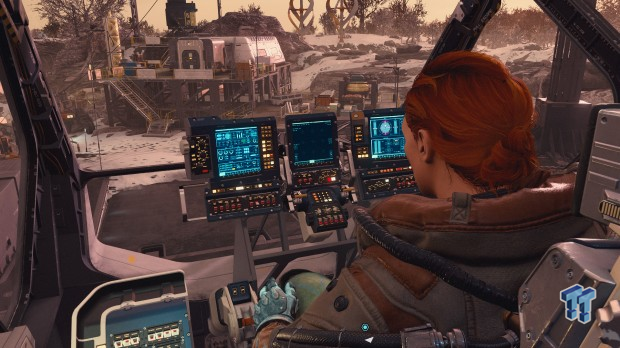
In today's modern era of gaming, nothing is more immersion-breaking than menu screens accompanied by load times. I've seen gamers say that Starfield is a "loading screen simulator," and while that's a snarky and sarcastic comment, there's some truth to this statement.
As such, Starfield is a game that prioritizes sequencing over other Bethesda games; can you properly remember the sequence of button presses and UI selections to more efficiently select your path so you don't waste any more time than necessary?
The loading times really do give you a kind of anxiety or a push to make sure you can save time. The fact that we even need shortcuts for various menu screens is a major friction point that will pull gamers out of the experience.


The inventory screens are colorful and appealing--a big step up from Skyrim's inventory menus. The ship-building menu is also likewise as appealing to look at.
The UI serves the overall mechanics and style of the game--the latter of which was a deliberate choice that Bethesda stuck with. I think this deserves respect, especially because the studio created a vision, stuck to it, and tried something new. It's just that gameplay sometimes feels more meticulous than it needs to be.
It has to be said that I actually enjoy Starfield's UI, but that's only because I'm used to it now. At first it was kind of frustrating, but also an enjoyable mystery to solve. I'm well aware of the UI's flaws, principally how it complements the loading times to deliver something that doesn't really feel like a game, but overall, I still approve of the interface and find it innovative and interesting.
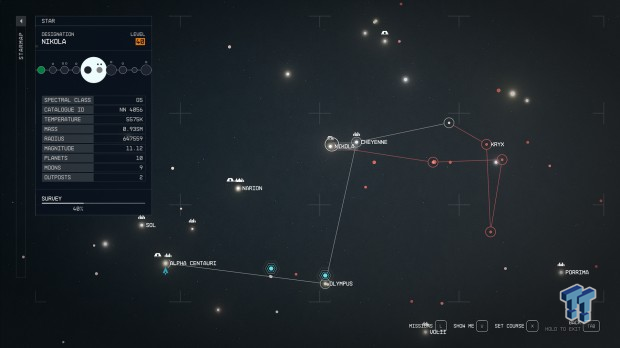
The starmap is extremely appealing to look at, especially on PC where the details can be much more refined. Bethesda has put a lot of effort into the starmap, complete with lines denoting gravitational pull of stars and planets, along with orbital paths that are traced.
This actually adds a lot of immersion and makes you feel like you are a captain in control of the ship, but some of these finer and more granular details are lost a bit on console, especially when playing on a big-screen TV. The map has three levels: star, system, and planet, all of which show you different data.

The star system is what you select on a more general and broad basis, and the system map will have all of the different individual planets, moons, and the main star that everything orbits around. The planet map is where you can plot your course and select the area of the planet you want to land on. This creates a kind of illusion of scope; selecting an area and being able to land on it will yield different exploration opportunities, but as we said before, the exploration isn't as exciting as we'd have liked. It's a lot of walking and sometimes shooting and looting.
Looking at planets in Starfield is just as cathartic as planet-gazing in Mass Effect Andromeda's excellent planet maps, even more-so here with the general advanced interface and colorful design.
Characters and NPCs
I'm not a fan of the characters in Starfield. The models look good, the speech audio is fantastic, and I think the voice actors all do a good job. I also like the various scenarios and situations that the NPCs and characters find themselves in, but as for the main cast, things could be much better.


I don't really like any of the main cast outside of Andreja, and the Constellation crew is much too slipshod, ramshackle, and unrefined for my expectations. The game sends mixed signals in this regard; it makes it seem like Constellation is some grand exploration troupe with some level of professionalism, but in reality, they feel...just like an ensemble cast without a whole lot of substance.
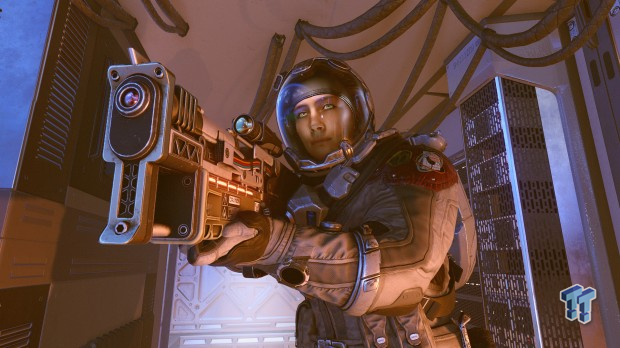
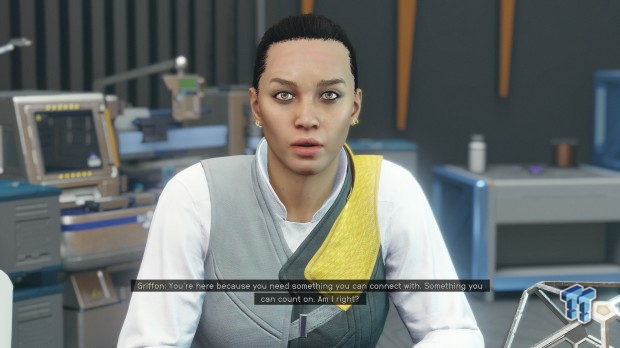


Sam Coe is my least favorite character for a number of reasons (mainly because he thinks it's okay to bring his child into haphazard and foolish jaunts across the stars), which is a shame because he's played by Adam Jensen actor Elias Toufexis. I feel the characters, including the companions and most of the actual NPCs in the game, are simply...droll.
I actually find more to like about secondary NPCs than I do the main characters.

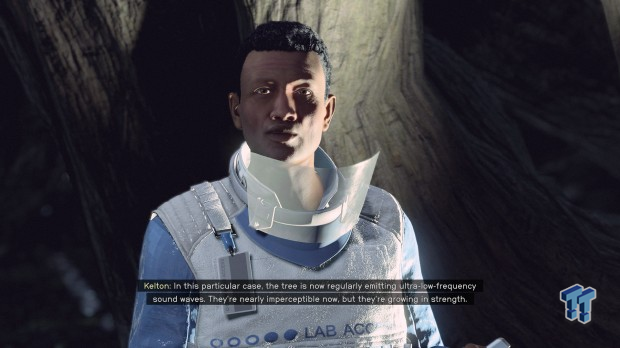


This was a big missed opportunity to match Starfield's 1960s space race style with a more high-tech and advanced society--one that is more organized and couth. It's kind of a tough thing to explain, but Constellation (and most of the actual characters and NPCs in the game) feel very amateur and unbelievable, clashing very hard with the setting and tone that Starfield originally gave me.


The Juno Probe might be the best NPC in all of Starfield...
This further breaks the immersion barrier for me, so I mostly choose to ignore NPCs insofar as becoming really invested. It's a shame, too, because all previous Bethesda games are replete with memorable characters. There's practically the entire cast of Fallout 3, Cait from Fallout 4, and Lydia from Skyrim, to name a few. But the cast in Starfield feels genuinely...well...boring and mostly unlikable for the simple fact that there's not a tremendous amount of personality exuding from any of them.




Ultimately, I would say that the characters in Starfield feel watered down. That isn't to say all of them are bad--you'll run into some awesome people along the way, including random passersby in space who will tell you jokes and grav-jump before finishing the punchline, and even a crazy AI. Others like Vladimir are noteworthy, but my main point is that nearly all of the main Starfield cast should be memorable.
This is a new IP, after all, and characters are one of the largest influences on how players feel while they play.
Gameplay Loops - More of the Same
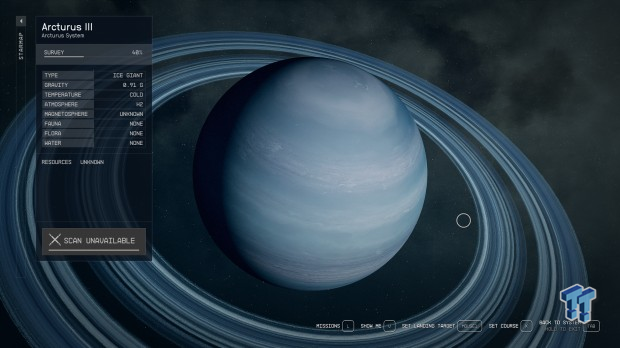
In many ways, Bethesda's new IP feels like it has a live service game approach. Not in the overall monetization structure, but in the gameplay loops.
All Bethesda RPGs are meant to be played for dozens (and potentially hundreds) of hours, but Starfield feels different because of how many different drivers and motivators that it contains.
Players are never limited to any one thing. There's a variety of reasons to go out into Starfield's planets and deep space locales, and a lot of the mechanics are organically interwoven with each other.
The only real issue is that there isn't much innovation here. In certain ways, Bethesda has opted for quantity over substance, lumping in a smattering of features to create a nice patchwork of activities and objectives...but some of them don't really feel worthwhile, at least to me.
You can legitimately ignore entire portions of Starfield's gameplay loop, and it won't really affect your playthrough at all. I haven't messed around with base-building all that much (despite being completely infatuated with it in Fallout 4), and the same goes for shipbuilding. Why? It's kind of an out-of-sight, out-of-mind sentiment, but it's also because I'm not connected to any of these things because of the wide nature of the game.
I felt overwhelmed at certain points due to the enormity of the game itself, and some systems didn't matter as much as a result.
Take ship-building, for instance.
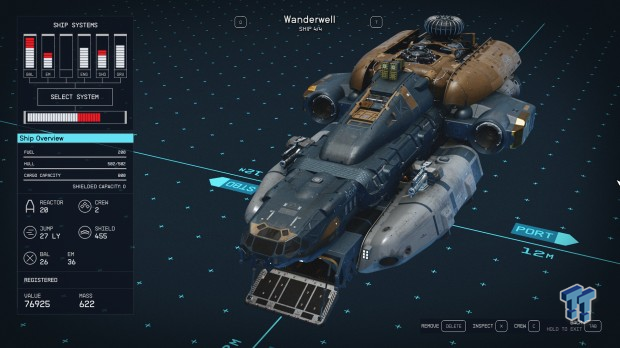
The main interface is excellent, and Bethesda has taken one of the best approaches possible with Starfield's shipbuilding. Pieces snap together like Lego bricks, and building that epic ship is a big reason to attain credits. It's one of the main spending points for the gameplay loop of attaining wealth; a big reason to earn credits in the game is so that you can spend them on customizing your ship.
Sadly, the pride you feel when creating that perfect ship is short-lived because you can't really use your ship outside of orbital exploration and dogfighting--which is typically only rewarding on a visual level, outside of dockable areas and brief random encounters.

You can't really fly your ship around freely, so there's a disconnect on how much you actually enjoy your ship's overall look and design. The game does afford you many opportunities to look at your ship, with cut-scenes for take-off and landing, but there's a lack of agency here.
The gameplay loops have a distinct pacing groove that feeds into the UI and serves into the overall scope of the game.


This is a Bethesda RPG, and we're all here to build up our characters and become space superheroes. Leveling up, assigning skills, and experimenting with different builds is just as much of a hallmark in Starfield as it is in other games, but this time around, combat is a lot less...chaotic.
This is because there's no magic in Starfield. Yes, you do get Starborn powers, which is essentially a very basic sci-fi adaptation of Skyrim's Dragonborn. But there's no fire or lightning skills, no weight-reducing alteration spells. This makes sense, given the game's focus, scope, and setting, but it does feel detrimental to the overall formula.
Fallout didn't have superpowers either, but it did seem to have marginally better environmental storytelling in the way of substance and discovery. Fallout also had VATS in combat, which gave more opportunities for hilarious hijinks and generally made combat more flavorful. This helps offset some of the comparatively slower FPS combat sequences.
Everything you do in Starfield feeds into the XP level-up loop; exploring planets will yield XP, doing quests will reward XP, killing enemies, etc. And you spend XP in the more straightforward way of leveling up via perks.
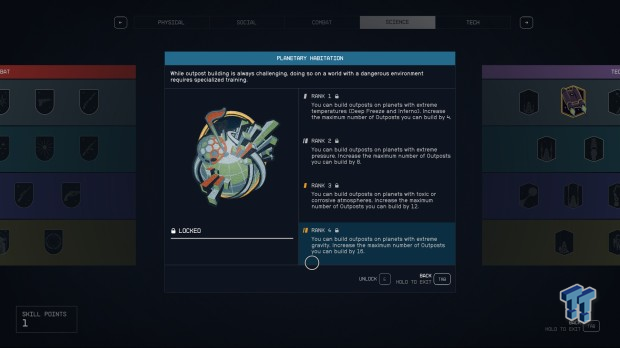
The perk system is interesting, but I still very much miss the attribute system featured in games like Morrowind and Oblivion. Starfield's perk system feels like a carry-over from Fallout 4.
Honestly, the game isn't very challenging so you don't really need to devote too much into into min-maxing your builds. You can ignore sections of the skill tree, or save a point here and there if you need to pick a lock or pass a conversation check.
There's a whole portion of the skills that don't seem all that useful, though, and I feel like Bethesda stretched the perk system a bit too far. The Science tree, for example, sounds cool on the surface, but ultimately it's not all that useful outside of passive bonuses to very specific things--usually these things are the "spending areas" of the gameplay loop that you will spend resources and credits on.
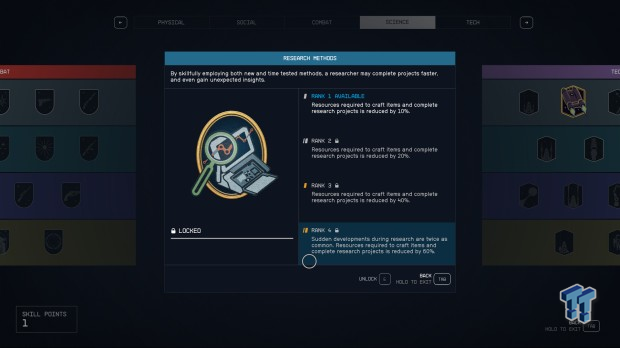
Gamers are better off prioritizing specific skills at first, like the weight reduction Weight Lifting perks alongside the Fitness perks. Being able to hold a ton of stuff at once is a big part of any Bethesda game (we're all packrats at heart), and you'll need some extra O2 in this game as well.
Another part of the loop is scanning, but this is more ancillary and secondary. You can mostly ignore scanning areas, and you'll be fine (unless you want to build stuff). But it's a part of exploration that makes things more interesting and, at times, more immersive.
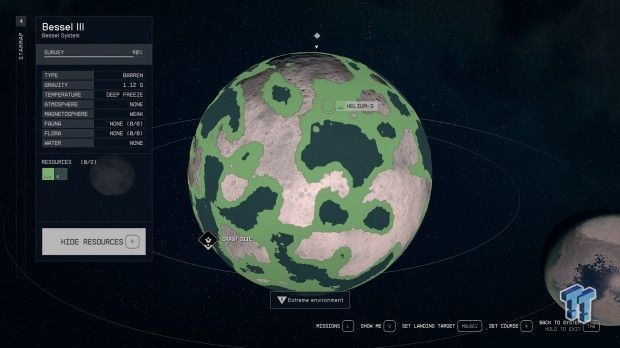
Scanning also feeds into base building.
You'll need resources to build stuff in Starfield, and that can come from mining on planet surfaces. Just like Mass Effect, each planet will have its own resource characteristics.
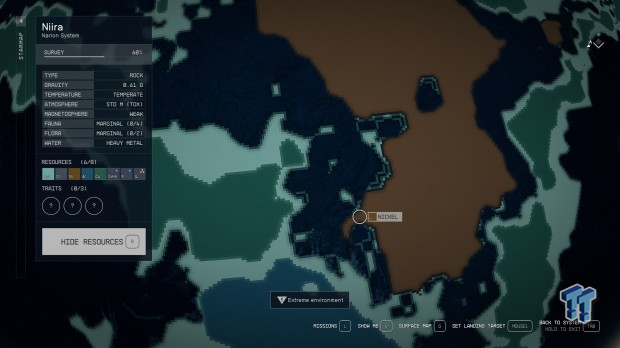
Each part of the planet is different and laden with various resources, which makes exploration more interesting; if you're looking for a vein of chromium, you'll want to scout around and scan planets from the system menu and land on the surface.
Once you're there, you still need to find the actual vein on the planet. This is an interesting little mini-game of hide-and-seek, but ultimately, it loses its luster because it's just not very fun on a long-term basis. It feels like busywork, even if it's presented in a colorful way.


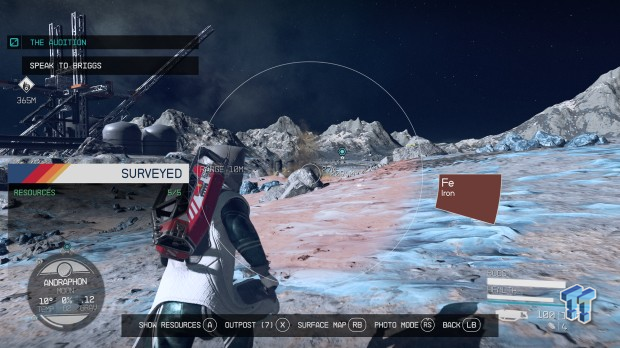
This brings us to the antagonist mechanics that make the gameplay loop worthwhile. Starfield has various friction points that it eases over time as players level up and attain resources, creating the illusion of growth and development.
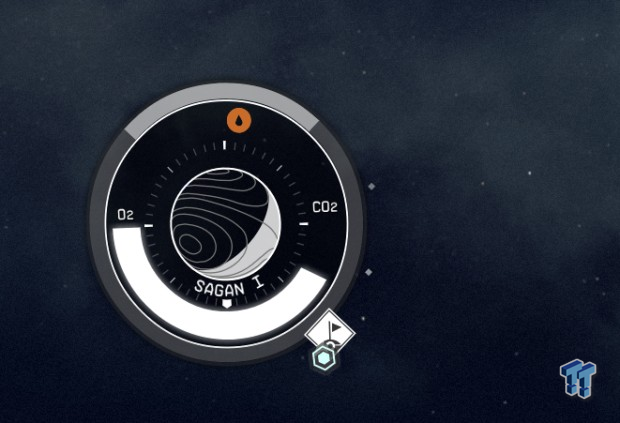
The largest friction point is the new O2 system, which is entirely innovative, interesting, and genuinely fun to work with. Managing your O2 is directly involved with your weight management, and creates a kind of mini-game within the gameplay loops.
Starfield has no fatigue or mana, but it does have an oxygen system. This is kind of a combination of both things, but is more weighted towards fatigue.
Running in Starfield will use your O2, and when it runs out, you still have a secondary CO2 bar that can fill up before you're completely out of breath and keel over.

Apart from the O2-CO2 push-pull relationship, the novel thing about this system is that you can still technically move around while being over-encumbered. Carrying too much weight will just drain O2 while walking, and even faster while running, but you can still move around at a rapid speed. This gives you an extra edge while exploring planets and you're far away from your ship, or when you need to transport a metric ton of loot that you want to sell at a vendor.
This is easily my favorite mechanic that Starfield offers. I've had a lot of fun managing O2 and CO2 while running around in the game and find this to be much more freeing than any other Bethesda game.
The normal antagonist staples are there--you'll move slightly slower while over-encumbered, and you can't fast-travel, but it's clear that Bethesda wanted to give players a little bit more wiggle room with Starfield. It doesn't go unnoticed, and it's very much appreciated.
Skills and loot are the key ways to mitigate this antagonist mechanic. Gear is itemized with prefix mods that allows players to get incredibly optimized gear for their builds.


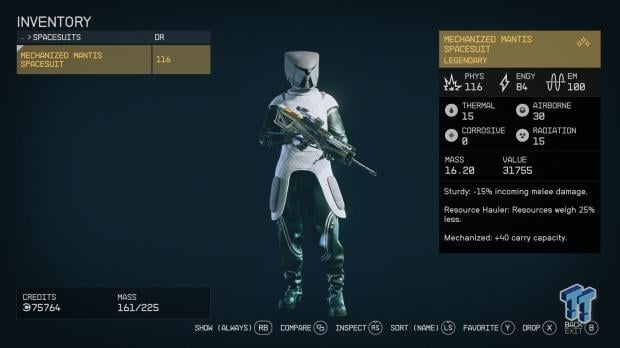
For example, if you're a packrat like me, then you want to prioritize gear that has these mods:
- O2 Boosted +20% oxygen capacity
- Assisted Carry Drain 75% less 02 when running while encumbered
- Mechanized +40 carrying capacity
- 02 Filter -25% oxygen consumption
Another cool thing is that these parameters aren't static and are affected by planetary conditions.
Planets with lower gravity will let you jump higher and move faster, making exploration a breeze in these areas, even if you're radically over-encumbered.
Quality of Life Improvements
Remember those quality-of-life improvements we talked about? Bethesda has looked out for players in a number of ways.
For example, you can fast-travel to another star system or planet if you're near your ship. You don't actually have to enter your ship in order to fast-travel to other areas (provided you aren't over-encumbered).
Gamers also do not have to attain any kind of fuel or recharges for their ship in order to fast-travel to other systems.
Bethesda took a more player-friendly approach here, contrasting starkly with No Man's Sky, which requires you to amass resources before you can jump to other systems. This is a nice trade off that makes the gameplay loop go more smoothly, especially when organically trying to feed into other aspects of the loops; scanning, collecting, building, leveling up.
Feeding the Loop - Rewards Systems
Starfield has two main rewards systems:
- Accretive and incremental push-back against the antagonistic friction points and;
- The visual style of the game itself
The first is par for the course with any video game. You start out at level 1, relatively weak, with lower-end gear. The strength curve ramps up as you play and gain items, experience, and know-how. Eventually, you'll level up and break past certain gates, like being able to carry a ton of weight, sprinting for longer periods of time, and improving your skill at stealth, digipicking, or trade/persuasion.
The illusion of an actual interactive experience is kept in check by a combination of systems + immersion. The total breakdown of the entire thing is typically kept at bay through a series of meaningful interactions, impressive visuals, and player agency. Starfield delivers on some of these things, and not very well at the others.
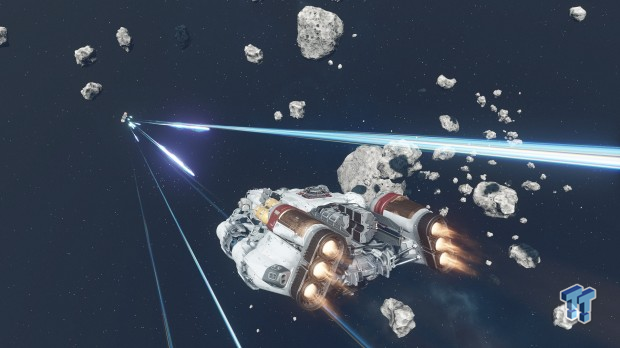

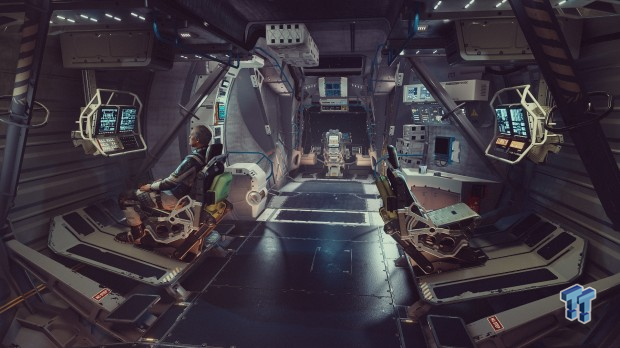

Unlike past Bethesda games, the magic spell breaks down for me while playing Starfield.
The artifice remains clear to me during certain parts of the game, namely the immersion-breaking loading screens and mostly-bland NPCs. It's not just that the characterization of the NPCs just misses the mark for me, but also these characters feel like what they actually are: Static setpieces that are just waiting around for player interaction.
Due to the size, scope, and scale of Starfield, this makes sense--Bethesda can't do it all. But even still, I would like more actual meaningful interactions with the characters vis-a-vis side quests and in the main storyline.


So...why do I continue to play Starfield? What's in it for me?
The game's visuals go so far above and beyond what I expected, and they are the biggest motivation for me to keep playing.
Let's explore that a little bit farther.

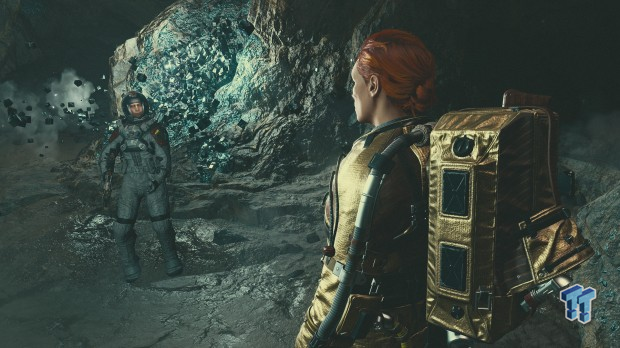


Visuals - Sci-Fi Splendor & Influences
When it comes to style and visuals, Starfield is a heavily derivative game. Bethesda was influenced by decades of sci-fi pop culture media, from the refined and advanced tech of Star Trek to the worn, tattered, and ragtag scrap-ships of Star Wars.

Examples of Starfield's retro futurism influences, including artwork from Syd Mead. Photo Credit: GraphicDome
Starfield incorporates themes and elements from some of my favorite things on the planet, whether it be the retro futurism of Syd Mead's concept art, or the blazing and colorful sci-fantasy paintings of John Berkey. The game is resplendent in its visuals and it's clear that Bethesda's art department are incredibly talented and well-attuned to the style of the game.
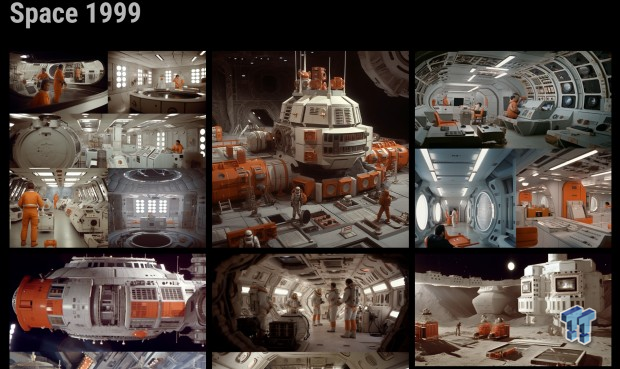
Much of Starfield's design is based on movies and TV shows from the 60s-70s era, with lighter influences from the 80s. Photo Credit: ArtificialMatt
One thing that became clear to me from the beginning of my playthrough is that Starfield is made by people who grew up during the hey-day of technologically-advanced sci-fi, which was around the late 1960s onward.
This is a game made by people who grew up watching shows like Space 1999 and Kubrick's 2001: A Space Odyssey, both of which are significant influences for Starfield's style.
Although Starfield is a kind of patchwork that's influenced by so much external media and history, the game still manages to create its own stylish identity (unfortunately, the game mechanics and characters can clash with this style design, which can further break down immersion).
The spectrum goes far beyond fiction, though.

The Bell Systems Pavilion featured in the New York World's Fair. Photo credit: University of California.

The Eastern Kodak Pavilion from the 1964 World's Fair. Photo Credit: The Atlantic, AP Photo/John Lindsay.
Starfield is replete with design choices lifted right from the 1960s Space Race era; from the retro color palette to the old-school motifs and fonts, the game delivers a kind of golden optimism. Constellation, for example, is a kind of fictional NASA that searches the cosmos for answers to the mysterious artifacts.
We also have influences from the 1964 World's Fair, which can be seen in New Atlantis and other areas of the game.
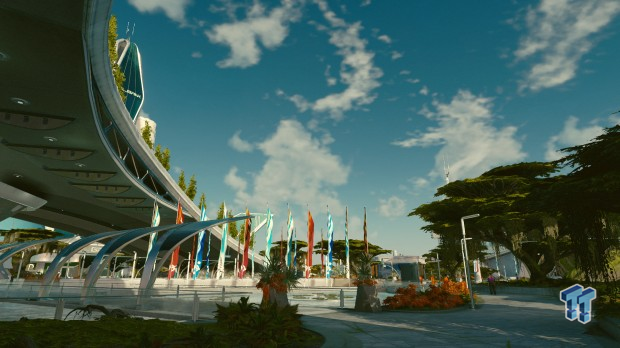

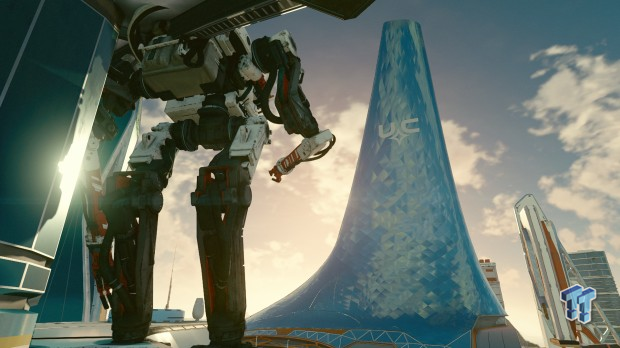

Then there's the cities themselves.
Bethesda Game Studios has created some of the most beautiful, unique, and genuinely visually-appealing buildings, stores, and overall futuristic environments that I've seen in gaming. These areas are so enjoyable to look at that they remain one of the core motivations for me to keep playing.
I never know what I'm going to find, how it's going to look, and what kind of references it will connect to. It's a kind of digital interactive scavenger hunt where I feel compelled to uncover more and more of these visuals--these images that are based on some of my favorite paintings, concept art, films, and TV shows.



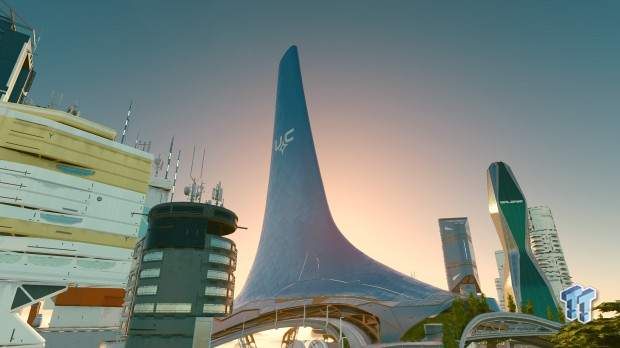









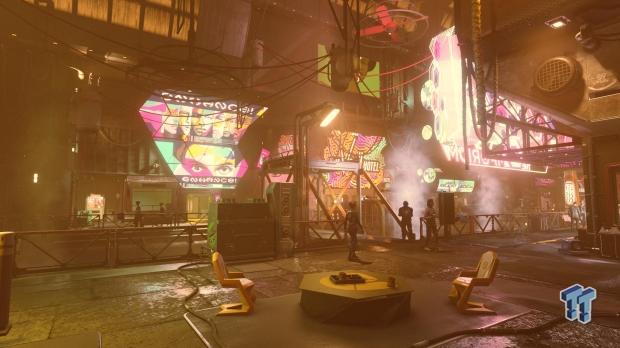
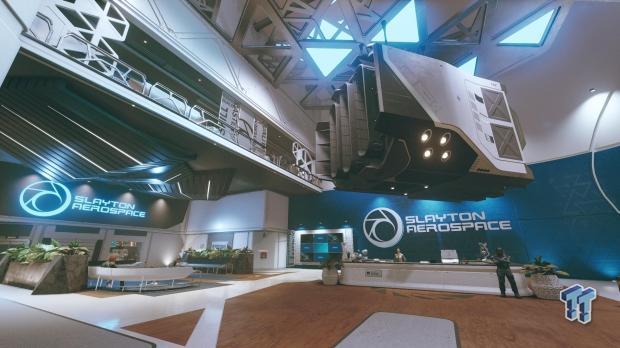


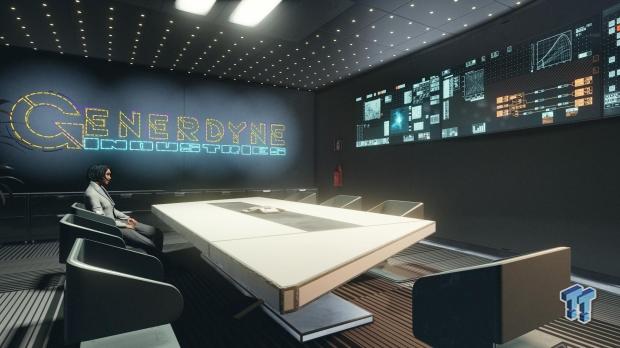

















Procedural Generation - A Boon or a Bane?
The biggest departure for Starfield is the game's new procedural generation tech.
Bethesda's planets are procedurally generated areas, meaning they won't always have the environmental storytelling and nifty little secrets that are found in its past games. This design choice is part of Bethesda's vision for a wide cosmos to explore. There are still awesome things to find, though, and this time around, it's a real treat when you find them.

The real issue here is that only 100 of the 1,000 planets have life on them, and that the planets themselves aren't all that engaging to explore. There are bases here and there, with enemies dropping onto the surface at times to keep things somewhat exciting, but there isn't much of a magnetic or gravitational pull attracting players to explore the planets.

Sure, you can take in the impressive visuals that make you feel like you're in the middle of a space documentary, but players aren't always rewarded for their exploration in the way that they are in other open-world games like, say, Elden Ring or Tears of the Kingdom.
The other issue here is Bethesda's scope is so wide, and there's no way to traverse the distances outside of foot travel.
You get a jet pack to thrust around in, and while this is an awesome addition to the game that fundamentally changes the vertical reach and locomotion of the game, it doesn't replace an actual ground vehicle or your space ship. It's a neat idea on the surface, but the spans are pretty vast, and it makes planet-side travel a kind of monotonous task.


I personally don't mind this. I enjoy the quiet and solemn exploration that Starfield affords. It's reflective and isolative, lonely but beautiful, and generally a meaningful experience in its own right.
That being said, it might be hard for people who enjoy chaotic instant-action shooters or action games to really enjoy this. As a result, Starfield is polarizing in this respect, with many saying that it has the wide expanse of an ocean but it's also as shallow as a puddle.




I don't agree with this turn of phrase, but I can see the point. Starfield isn't necessarily shallow, but it is definitely elongated. I wouldn't say Starfield is stretched thin, but it is indeed stretched, and the seams can be obvious at times.
There are indeed times when Starfield feels hollow, and when I start to feel this, I just move on to a different game. To me, Starfield is one of the Bethesda RPGs that I can actually stop playing for a while, unlike Morrowind, Oblivion, or Skyrim, all of which kept my attention for many months on end.


The environmental storytelling that I knew and loved in practically all previous Bethesda games has been spread out across a ton of areas and planets.
Finding neat little additions went from a common occurrence to something that's more rare, which underlines their power but also makes their presence feel less magnified. It's because of this that the procedural generation and wide scope of Starfield is an overall weight to the game and the experience, with the gameplay being made up of a myriad of different systems that serve various gameplay loops.


The main point is that Bethesda has redefined its formula without making proper adjustments to certain things. If Starfield is to have 1,000 planets, then the studio needs to make sure there are enough interesting things to do on them in order to make the experience worthwhile. The reality is that there's not enough time or tech budget to make this feasible, so instead players are given an experience that feels half complete when it actually isn't.
Starfield's new formula breaks away from the old without making the course corrections needed to allow players to adapt; it's a stark difference, one that pulls the design apart like silly putty and stretches it across a wider span.


That being said, Starfield has the worlds and systems in place for a big evolution. Landing on a planet feels exotic, new, and interesting. Seeing the weird flora and the alien fauna feels exciting at first, and the planets themselves will often have different biomes depending on which regions you land on.
There's a lot to see, realize, and explore in Starfield, but right now, there are not a lot of rewards for doing these things outside of resources and personal curiosity. For me, that's enough...but it might not be enough for someone who wants to spend hundreds of hours in this singular experience.
Wrap-Up and Score

I would condense this review with the following: Instead of being a 10 in a few spots like storyline, characters, and combat, Starfield is more like mid-range 6 or 7 in all of its various systems--NPCs, skills, UI, ship-building, combat, story, etc. Don't expect a genre-defining must-play system-seller but more of a derivative experience that puts great emphasis on capturing a distinct visual style, look, and feel.
For better or worse, it's Starfield's main design and scope that set it apart from its predecessors.
Bethesda's vision for the game is counter-intuitive to the core formula that the studio has established through years of iteration. The developers have tried something new here, and that takes courage and it's something we should respect. But at the same time, there is a tonal disconnect between the style of the game and its characters, and some technical issues like the long loading times go against what Bethesda is trying to accomplish here.

At its core, Starfield is a game that pulls against itself to such a degree that it can't exactly take off and rocket into the heavens above. Starfield is kind of stuck somewhere in between, and while it's not a game that will change how you think about interactive entertainment, it's still an enjoyable jaunt into a unique pocket of the universe.
Starfield is the convergence of passion, vision, and capability, but ultimately it tries to do too much at once. Because of this, Starfield isn't necessarily an Earth-shattering RPG.
But it is a Bethesda game through and through. It'll scratch that itch, but don't expect a Skyrim-level experience. This one is more thoughtful, methodical, and I believe it offers something special for the introspective gamer.




So, would I recommend that you buy Starfield?
That's conditional. If you're expecting some grand space opera with tons of meaning like, say, Mass Effect, but with a Bethesda RPG wrapper, then you might be disappointed. If you want something you can escape with for an hour or two every night, happen to love retro futurism and 1960s space age style, and generally love Bethesda's titles, you should be okay.
As a result of its unrealized vision, Starfield feels like a mostly finished game that needed just a bit more time in the oven.
What's Hot
+ Creation Engine 2 shines in some areas, new lighting systems are impressive
+ Memorable visual style that references pop culture and real-world imagery/space photographs
+ Jetpack is awesome and very fun to use
+ New O2/CO2 system is innovative and interesting
+ FPS combat is enjoyable enough
+ Quality of life shortcuts/adjustments
+ Exteriors, shops, cities, and interiors are sights to behold
+ Starmap interface is cathartic
+ UI is appealing and sophisticated on a visual level
+ Planet vistas are incredible
+ Analog space-age computer tech is delightful
What's Not
- Loading times are extremely frustrating
- UI can be confusing to navigate
- No local maps is a pain point, surface maps aren't great
- Environmental storytelling is too few and far between
- Some skills and perks feel unnecessary
- Can't fly your ship or manually land on planets
- Characters and NPCs are forgettable and not very interesting

